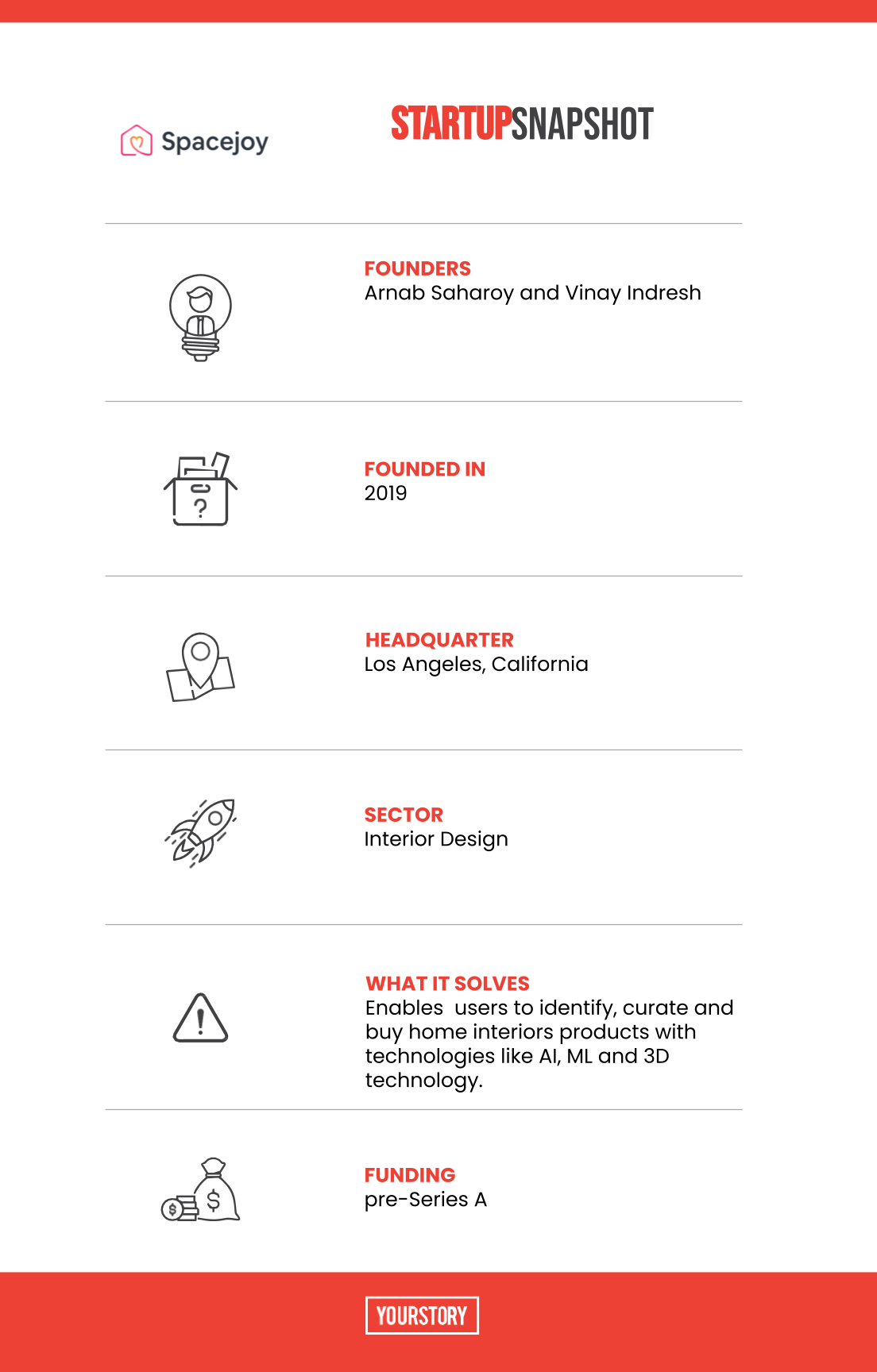For most people, the journey of home designing starts with social media platforms such as Instagram and Pinterest, where users discover and collect ideas to build a vision for their homes.
“But then, they don't know what to do with them, because there is no way to fulfil those ideas,” says Arnab Saharoy, Co-founder of Spacejoy, an ecommerce platform for users to realise their decor ideas. He founded home design startup Spacejoy with his friend Vinay Indresh in 2019.
In the traditional world, consumers either search and hire designers to execute their ideas, which may or may not be cost-effective, or go online or offline to buy these products. However, Arnab says tired of researching, trying to find the right fit, and being unable to visualise their dream décor, many consumers often end up compromising on their choice.
This is the problem Spacejoy is trying to solve – for the US market.
The Los Angeles, California-headquartered company allows its buyers to visualise their space with the products they want, and acts as a one-stop-shop to discover unlimited options for home brands.
“We married the best of both these worlds through the use of technology and design,” Arnab says.
What it does
On the Spacejoy platform, users can see thousands of pre-designed sets for each room, created by designers Spacejoy works with. They can select designs, and decide if they want to order the furniture and items used in different rooms.
“Everything is instant, and one need not wait for days to work with an interior designer,” Arnab claims.
A team of 30+ designers use different furniture and interior decor items to create the sets, mostly products from American retailers such as Wayfair, Pottery Barn, and Crate & Barrel. It has partnered with 35 retailers, who, in turn, are leveraging the growing popularity of online design-led commerce through these partners.
Arnab says Spacejoy’s offerings extend beyond pre-designed sets.
“As users can select different types of rooms, they have the ability to personalise the space according to their style, needs, and budget - in real-time,” he says.
When they are done with the design aspect, users can buy the products they have chosen - be it big-ticket items like furniture, fittings, and kitchenware or small units like lamps, furnishings, and décor accessories.

The genesis
Arnab’s first startup Bengaluru-based Homefuly.com was born six years ago out of the frustration to renovate his own home in India, which he realised wasn’t easy.
“I thought it would be as easy as buying a car. But I struggled and ended up spending the same amount of money as it requires to buy a car,” he says.
Homefuly, which he worked on with Vinay from 2016 to 2019, provided full-stack home and design solutions to its customers.
The experience helped him understand the nitty-gritty of the market – designing homes, cataloguing, selecting the right materials, and understanding designers’ and consumers’ mindsets. This formed the basis for building the next product.
“When I started working on designs with designers, I realised that there is a gap in how consumers can be a part of this process themselves,” Arnab says.
This time, however, he targeted the US market, having imagined Spacejoy as a consumer-led product.
With large players like IKEA, Wayfair, and Bed Bath & Beyond, the US is a consumer-driven market, with buyers renovating frequently with new furnishings, artwork, furniture etc. As per Research and Markets, the home decor market in the US is expected to be worth $283 billion by 2026, growing by 6.8 percent annually.
Apart from the web version, Spacejoy offers a 3D app that lets consumers design elaborately, keeping in mind the dimensions, requirements, and style.
For the app, Spacejoy builds a 3D catalogue of products, based on inputs from designers and user trends. It has the retailers’ inventory details, which helps determine the availability. This real-time info enables users to select and change different objects in the design room, according to what is available.
The app uses a simple drag-and-drop feature, and does not need sophisticated design software.
It uses image recognition and machine learning models to detect products from Pinterest images, and allows users to save them into a list, then curate ideas and, ultimately, buy them. It also relies on Artificial Intelligence (AI) to understand what consumers are looking for and what they want.
Spacejoy’s Bengaluru office has 22 people in the core team, which performs technology and marketing functions, and 60 people in its catalogue team. Its US team has four people and 30 designers on contract.
Fundraise and revenue model
In February 2022, Spacejoy raised $4 million in a Pre-Series A round led by Accel Partners.
"The global online furniture ecommerce opportunity is huge, and has seen rapid acceleration recently. Spacejoy wants to disrupt this industry using its interactive technology that democratises the home design process," said Subrata Mitra, Partner at Accel Partners, at the time of investment.
Prior to that, the startup had closed a $4.1 million round in November 2021 and garnered $1 million in 2019 in seed rounds led by Accel.
Spacejoy majorly earns through a margin on the products it sells. In the two years since its launch in November 2019, it has sold three and a half million dollars worth of products across the US.
It also has a premium service where users can opt to work with designers directly.
The company claims to have an annual revenue rate of $5 million, and is aiming to scale the business further in the US with new funds.
Edited by Anju Narayanan and Teja Lele

